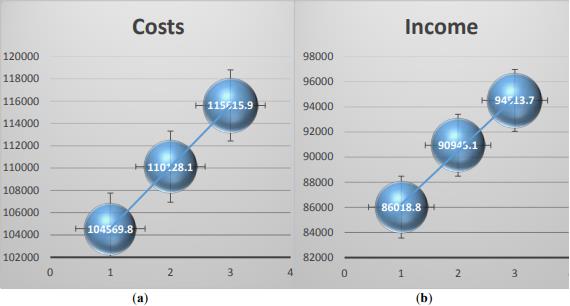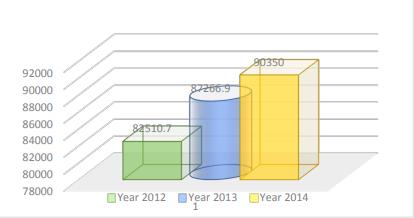Abstract
In the Romanian socio-economic context, in a society marked by permanent discussions regarding the sub-funding of the health system, we intend to apply an instrument to measure costs and benefits in the health system, by analysing a part of the economic indicators as well as the income and expenditures between 2012-2014. We shall estimate the socio-economic impact owed to the implementation of certain economic actions and policies in health. The method used is the cost benefit analysis which, by minimizing costs, we must obtain the maximum benefits. The results will provide an overall picture of the system because, in this study, we involved only the economic indicators. The cost-benefits analysis applied in health will always be a topic of discussion; there will always be answers to the question: What do we need to do to have a satisfactory health system for the majority of those involved?
Keywords: Cost-benefitshealth
1. Introduction
A performant health system is the one focused on the citizens’ needs (Vladescu, Astarastoae,
Scintee, 2010), in other words, in order to evaluate the citizens’ needs we first need to analyse the costs
and benefits of activities in the health system. Currently, numerous tools are proposed and applied for
the measurement of costs and benefits in health. Therefore, in the context of sub - financing the health
system “the extremely intelligent use of available resources” is important (Olteanu, 2011).
Around 1808, Albert Galatin, clerk of the American Treasury, proposed the method of cost-benefit
analysis, as work method regarding the water transportation. In 1844 Jules Dupuit, proposed the use of
cost-benefit analysis in the public investment field. But this method started to be useful in the
beginning of 1902, during the economic analysis of irrigation projects, namely in 1936, in preventing
and combating floods. Until 1960, the cost-benefit analysis was closely related to the investment
projects regarding water as economic resource. In about 10 years, around 1970, the cost efficiency
analysis method started to be used also in other fields of interest for society.
Thus, the cost-benefit analysis estimates and sums up the money equivalent of present and future
social costs and benefits, from the citizens’ point of view, related to public investment projects, in order
to decide whether they are for the public’s interest (Mosteanu & Iacob,
www.asociatiaeconomistilor.ro).
In health, in order to make the managerial act more efficient, besides the medical approaches, the
other economic, sociological and ethical types of analysis were imposed. The involvement of the
economic theory in the field of resource allocation from the health system materialised in instruments,
judgements and models that help in the justified adoption of decisions (Blodureanu, 2004).
2. Materials and Methods
The Cost-Benefit Analysis is an analytical instrument, used to estimate (in terms of benefits and
costs), the socio-economic impact given by the implementation of certain actions. The impact must be
assessed in comparison with the predetermined objectives, the analysis being usually done by taking
into account all individuals directly or indirectly affected by the action. (Ministry of the Economy and
Finance, p. 5)
The objective of the Cost-Benefit Analysis resides in the identification and quantification of
all possible action impacts in order to determine the appropriate costs and benefits. In principle, all
types of impacts should be assessed: financial, economic, social, environmental, etc. (…). Thus, the
cost-benefit analysis can be used as decision instrument for the evaluation of the utility of investments
to be financed from public resources. (Ministry of the Economy and Finance, p. 6)
A description of the cost-benefit analysis method was made by Henley and Spash (1993) and
by Randall (1987) which shows that “the purpose of the cost-benefit analysis is to highlight the fact
that the sum of impact effects is not higher than the net benefit of society.” The net benefit of society is
the sum of monetary and non-monetary benefits given by a rational exploitation of the environment
(Banacu, 2004).
The statistical data used are public data from the site of the National Institute of Statistics and they cover the period between 2012-2014 (National Institute of Statistics).
3. Results
I studied the period between 2012-2014 from the point of view of total income and expenses. The analysis indicates there is an ascending economic deficit so that, if in 2012 the deficit was -18551 million lei RON, in 2013 it was -19183 Million lei RON, and in 2014 it reached -21102.2 Million lei RON. If the overall costs are higher than the income, then it is obvious that in health we are dealing with the same trend. One can notice in Figure


For an efficient assessment of the benefit in health services, the following formula was used:
F s V s −C s −I s , (1)
Where:
F s cash _ flow V s income _ year _ ; s C s cos ts _ year _ ; s I s investments _ year _ .
4. Discussion
After a simple analysis, one can notice that the cost-benefit analysis is a method that provides
immediate results if all indicators are taken into account. In this part, I only highlighted 4 economic
indicators (cash flow, income, expenses and investments). The study will continue by exploring also
human and social resources (doctors, nurses, patients). The cost-benefit analysis is an economic-
mathematical instrument which helps the decision making process in terms of economic resources
allocation by minimizing the expenses and by maximizing the benefit.
5. Conclusions
Considering the mobility of economic and social factors involved in the decision making process,
one can say that the process of minimizing costs and maximizing benefits is quite arduous and difficult.
The health policies do not provide efficient solutions due to the economic and political instability of the
last years, and the cost-benefit analysis applied in health will always be a current topic of discussion
(Nica & Sandu, 2013).
When anticipating consequences or estimating the probability of an alternative, the researchers
count on the technical analyses of managerial sciences, especially from economy and operational
research such as prognosis, simulation, cost-benefit analysis, linear programming, critical path method
and Markov models (Enachescu & Florescu, 2007, p. 5)
The paper “The assessment of benefit in the health system” applies the econometric of cost-benefit,
thereby utilizing a small number of indicators. The scientific literature does not produce one
econometric model, with global applications, as such, it is interesting not to dwell on the ethical
allocation of resources, but on the principle of the benefit ethics and on the ethics of the access to
health services. (Dragomiristeanu, 2006).The original intake of the paper consists of the economic
indicators employed and of the results achieved.
References
- Banacu, C.S. (2004). Cost–benefit analysis (CBA), Useful tool for feasibility studies on investments from public.
- Management, 1(2004). Available online: http://www.management.ase.ro/reveconomia/2004-1/15.pdf Boldureanu, D. (2004). Statistical methods in health economics. The Journal of Preventive Medicine, 12(1-2), 62-65. Available online: http://www.jmpiasi.ro/2004/12(1-2)/9.pdfDragomiristeanu,A. (2006). The ethics of resource allocation and the process of purchasing health care services.
- Romanian Journal of Bioethics, 4(1). http://www.bioetica.ro/index.php/arhiva-bioetica/article/view/413 Enachescu, D., Florescu, S. (2007). Management în sănătate. Metode şi tehnici actuale în cercetarea serviciilor de 3/2007 Available online: sănătate.
- http://journal.managementinhealth.com/index.php/rms/article/viewFile/70/149.....pag%205 (p.5) Ministry of the Economy and Finance – Authority for the Coordination of the Structural Instruments, Guide to.
- Cost-benefit analysis of investment projects -, Available online: Http://Www.Metodologie.Ro/Ghid%20ACB%20RO%20proiect.Pdf (p. 5) Mosteanu, T., Iacob, M., Theories and approaches regarding the purpose and principles of cost-benefit analysis.
- International conference Financial and Monetary Policies in the European Union, Available online: http://Www.Asociatiaeconomistilor.Ro/Documente/Conferinta_FABBV_Romana.Pdf#Page=7(p.8) National Institute of Statistics. Available online: http://statistici.insse.ro/shop/ Nica, E.-A., Sandu, A. (2013). Study on the national endoprosthetics program based on the cost-effectiveness analysis and the Kuhn-Tucker optimality conditions. Romanian Journal of Bioethics, 11(1).
- Health Economics (I), Medica Academica. Available online: Olteanu, M. (2011). Based Http://Medicaacademica.Ro/Medicina-Bazata-Pe-Economic-I/ Vladescu, C., Astarastoae, V., Scintee, S.G. (2010). A health system focused on citizen’s needs. Romania situation analysis (I). Romanian Journal of Bioethics, 8(2), 7-16. Available online: http://www.bioetica.ro/index.php/arhiva-bioetica/article/view/169/267
Copyright information

This work is licensed under a Creative Commons Attribution-NonCommercial-NoDerivatives 4.0 International License.
About this article
Publication Date
04 October 2016
Article Doi
eBook ISBN
978-1-80296-014-3
Publisher
Future Academy
Volume
15
Print ISBN (optional)
-
Edition Number
1st Edition
Pages
1-1115
Subjects
Communication, communication studies, social interaction, moral purpose of education, social purpose of education
Cite this article as:
Nica, E. A. (2016). The Assessment of Benefit in the Health System. In A. Sandu, T. Ciulei, & A. Frunza (Eds.), Logos Universality Mentality Education Novelty, vol 15. European Proceedings of Social and Behavioural Sciences (pp. 668-672). Future Academy. https://doi.org/10.15405/epsbs.2016.09.84

